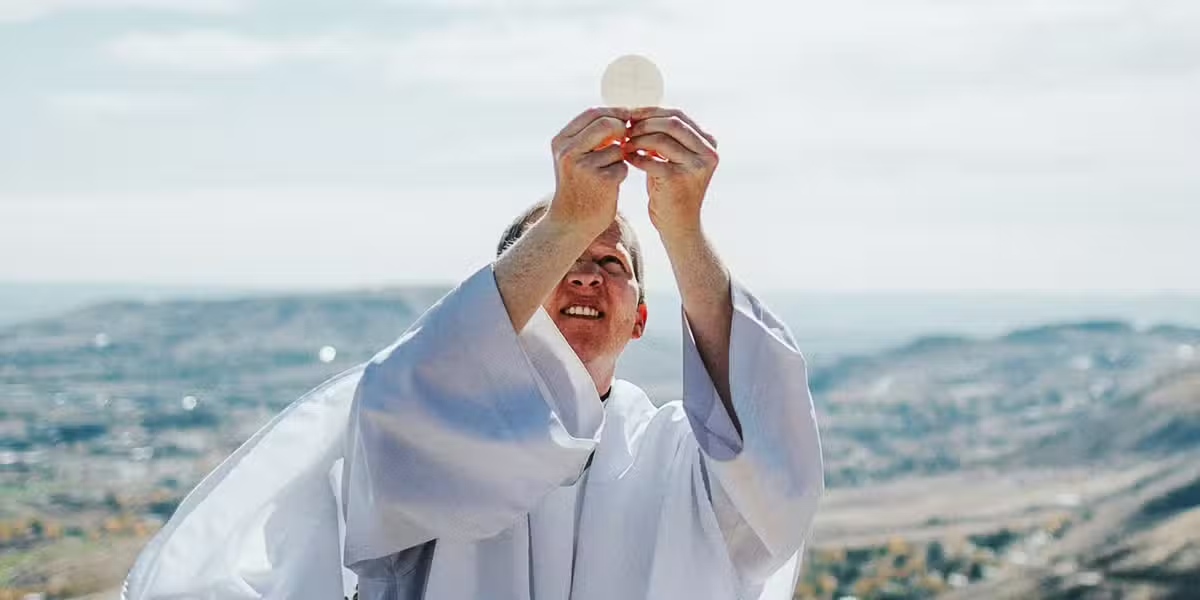On October 3, 1226, Francis of Assisi died. Franciscans worldwide observe this day as the Transitus: his journey from this life to the next. Every year, Franciscans all over the world celebrate the Transitus, or passing, of St. Francis with a memorial service that often includes a reenacting of St. Francis’ final hours, storytelling, and singing, keeping alive the spirituality that Francis and his early companions left us.
The most famous and most widely read of the early collections of Franciscan stories emerged around the year 1330 in the Marches (borderlands) of Ancona, Italy, and was called The Little Flowers of Saint Francis. From that classic of Western literature and other early sources, I have selected a few of the original stories about the death of St. Francis. These reflections are written in gratitude for the life and spirituality of Francis of Assisi, who continues to inspire countless seekers to embrace the joy found in walking in the footsteps of Jesus.
Obedience in Death
One of the brothers once asked St. Francis what kind of a death he hoped for: a quick, unexpected death or a prolonged, painful death. And St. Francis said, “Brother, I want whatever death God wants for me.”
What faith, what love there is in that answer! It reveals St. Francis’ total surrender to the will of the “most high, all-powerful, all good Lord.” It echoes the words of Jesus in the Garden of Gethsemane, “Father, not my will, but yours be done,” and on the cross, “Father, into your hands I commend my spirit.”
The surrender of Jesus to the very Trinity of which Jesus is the Word is the ultimate act of love of the Beloved, whom Francis had embraced as a young man, the crucified Jesus who said to Francis through the lips of the San Damiano cross, “Go and repair my house, which, as you see, is falling into ruin.”
The Wounds of Christ
It was on Mount La Verna, two years before he died, that Francis himself completed his repair of God’s house when, like Jesus, he emptied himself of whatever was keeping God’s house from being repaired and surrendered his life to the will of the Father as the ultimate act of love.
So strong was Francis’ love of Christ that the selfless love within him broke through his own body in the form of the sacred stigmata, the wounds of Christ crucified. It is a wonder that Francis did not begin to rise toward heaven then and there. But, of course, such spiritualism would be a denial of the mystery of Christianity: the incarnation of God in Jesus who, though God himself, suffered a very human death.
So, too, incarnate love kept Francis human, as well as shot through with the Spirit of God. He lived two more years in pain and suffering that were transformed by God’s voice shortly after Francis returned from Mount La Verna to Assisi. Francis had been away on Mount La Verna in Tuscany for a couple of months on a retreat in honor of St. Michael the Archangel, whose feast fell quite near the feast of the Exaltation of the Holy Cross. During that retreat, on or around September 17, 1224, Francis received the wounds of Jesus in his hands and feet and side.
When, a month or so later, he finally returned to Assisi, he went first to the monastery of St. Clare and her sisters, where a humble lean-to had been constructed on the side of the monastery. He was, practically speaking, blind from trachoma, an eye disease he had picked up in 1219 in Egypt during the Fifth Crusade. He was also suffering from what seems to have been tubercular leprosy, and he was hemorrhaging from the wounds of Christ.

Weak and frail and saddened by the direction some of the friars were taking the order, Francis lay in the dark of his improvised hut with field mice scurrying over his body for over 50 days with only Brother Leo, his scribe and confessor, by his side. His pain became so extreme that at one point he cried to God to help him bear his suffering with patience.
God answered his prayer, saying, “Tell me, Brother: if, in compensation for your sufferings . . . you were given an immense and precious treasure: the whole . . . earth changed into pure gold, pebbles into precious stones, and the waters of the rivers into perfume. Would you not regard the pebbles and the waters as nothing compared to such a treasure? Would you not rejoice?”
Francis answered, “Lord, it would be a very great, a very precious, and inestimable treasure beyond all else that one can love and desire.”
“Well, Brother,” the voice said, “be glad and joyful in the midst of your infirmities . . . as of now, live in peace as if you were already sharing my kingdom.”
Immediately, Francis was filled with joy because he knew he was already in God’s kingdom. Although he was suffering, all of creation had already been transformed for him so that when he died, not only would he join God in heaven, but he would also see all of creation transformed just as he had been told it already was. What he had seen in the vision of God’s voice, he would see with his own eyes.
He was so excited that, the next morning, Francis called his brothers together and sang to them the “Canticle of the Creatures” that he had just composed. And as he sang, Francis’ words revealed a new understanding and vision of the universe God had created, a vision of the transformation of everything we see around us in a new creation where there is no pain or suffering.
Our Sisters and Brothers
In his “Canticle of the Creatures” Francis praises God through creatures and very specifically through the four elements of the universe: earth, water, air, and fire. He embraces them as his brothers and sisters: Sister Earth, Sister Water, Brother Wind and Air, and Brother Fire. These transformed creatures show forth the goodness and glory of God, all of them having been redeemed by the mystery of the incarnation of God in Jesus. We and they give glory to God not by becoming pure spirit, but by being who we are: creatures overflowing with the spirit of God.
St. Francis realized that in surrendering to his own humanity, his own creatureliness, he was already rising even as he continued to live for two more years. It was as though he had turned, as Jesus had encouraged us, and become a child again.
St. John of the Cross once said that the Resurrection is interior to the cross. And Francis certainly was inside the cross of Jesus for the last two years of his life, but he was also seeing anew. As Franciscan Friar Eloi Leclerc said in The Canticle of Creatures: Symbols of Union: “Purified vision is attained only through a kind of agony—when we have become poor enough to welcome such purity and innocence. What chaos we must have within us if we are to see the world born again into the light! It is always in the shadow of the crucified Christ that the Christian, at the end of the journey, recovers the vision of the child.”
Meeting Sister Death
When he finally was nearing his physical death, Francis returned to the hearth of the order, the Porziuncola, or Little Portion, as he called the small chapel of St. Mary of the Angels on the plain below Assisi. He asked to be laid naked on the ground so he could die in total poverty with nothing of his own, like Christ on the cross. He knew that in that space and in that place, Sister Death would be able to find him and embrace him. In his “Canticle of the Creatures,” even death itself becomes a sister to Francis: When she comes to him, she will find him “in God’s most holy will.”
He reached out, too, to his dear friend, Lady Jacoba dei Settesoli, in Rome. He asked Brother Leo to write to her, telling her he desired to see her before he died, adding: “I ask you to bring some cloth for a tunic, the color of ashes, like the cloth made by Cistercian monks beyond the Alps. Also, bring some of your sweet cookies made of almonds and honey.”
How endearing this request is, and as Brother Leo was copying down Francis’ words, Lady Jacoba was already on her way to Assisi, having been told in prayer to leave immediately for Assisi if she wanted to see Francis alive.
When he had been laid on the barren ground, Francis asked that the passage in John about Jesus washing the feet of his disciples be read aloud. When the Gospel words had been spoken, Francis responded by reciting his favorite psalm, 142, and asked those present to join in. A few days later, according to St. Bonaventure, “When all of the mysteries were fulfilled in him and that most holy soul was released from the flesh and absorbed into the abyss of the divine brightness, the blessed man fell asleep in the Lord.”
A Loving Embrace
All these details are given to show us how close St. Francis was to creatures, and they to him, and how he taught us how to die, as well as how to live. St. Francis embraced his death as he embraced his life: with love. He demonstrated graphically that everything is God’s gift—even death itself—if we but embrace it with love and make death not only a portal through which we pass into eternal Love, but also a song of praise to God for giving us “Sister Death” to accompany us and reassure us that she has indeed found us to be in God’s most holy will.
St. Francis himself sings just such a mantra of hope at the end of his “Canticle”:
Praised be you, my Lord, through our Sister
Bodily Death
From whom no one living
Can escape.
Woe to those who die
In mortal sin!
Blessed are those whom she
Will find in your most holy will,
For the second death
Will do them no harm.
Praise and bless my Lord,
And give him thanks and serve him
Humbly but grandly!
Such is St. Francis; such are all who live and die in God’s most holy will and who die welcoming their Sister Death, whom they know will do them no harm.
The Death of St. Francis
It is said that one of the brothers saw the soul of Francis ascending straight to heaven. Brother Thomas of Celano, Francis’ first biographer, added these details about St. Francis’ death in his Treatise on the Miracles:
The larks are friends of daylight and shun the shadows of twilight. But on the eve that St. Francis passed from this world to Christ, just as twilight was descending, the larks rose up to the roof of his cell and began circling it with clamor of wingbeat and song. No one knew if they were singing with joy or sadness, for their voices were filled with joyful tears and sad joy, as if they were orphaned children weeping and singing their father into heaven. The city guards who were keeping watch there were filled with wonder, and they summoned others to witness the sight.








